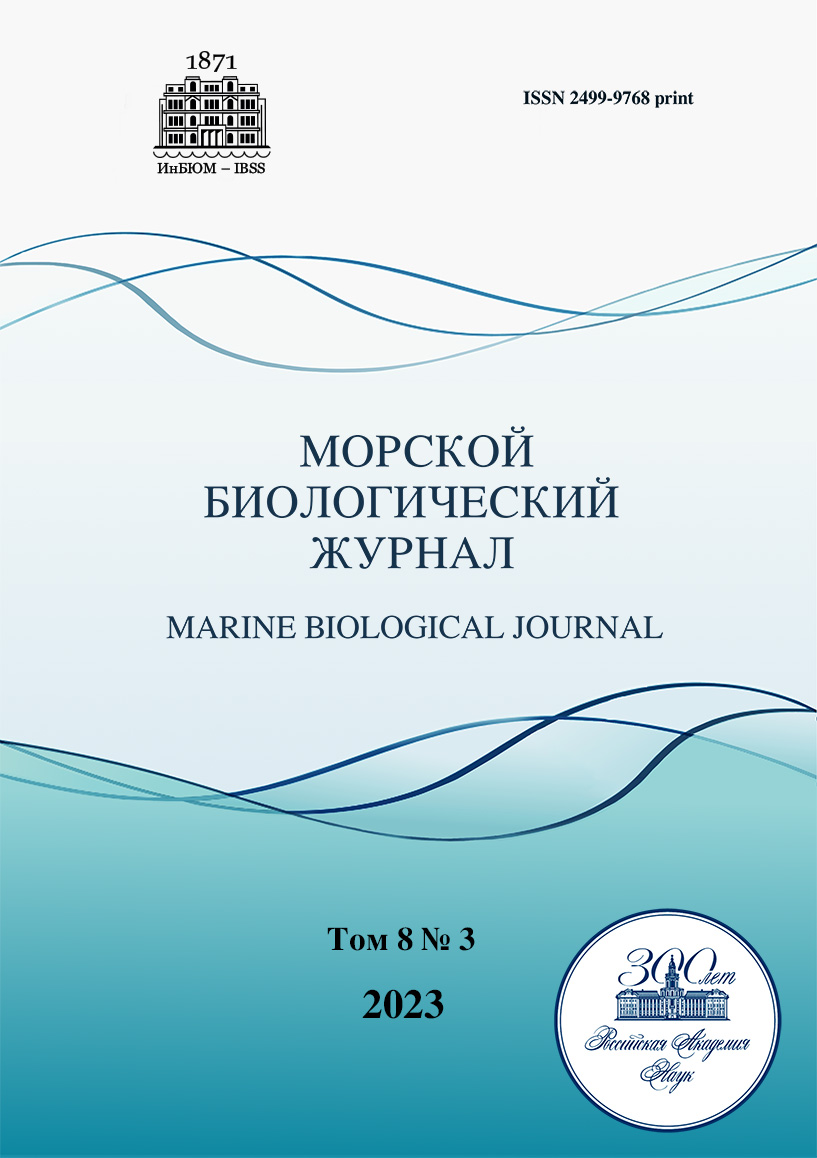Discoordination of Hoilungia hongkongensis (Placozoa) movements in the presence of Zn2+ ions
##plugins.themes.ibsscustom.article.main##
##plugins.themes.ibsscustom.article.details##
Abstract
Placozoa are the simplest multicellular organisms with a dynamic body plan. Calcium ions play a significant role in maintaining the integrity of these animals. We studied the effect of zinc ions on the interaction of Hoilungia hongkongensis cells. The coordination of amoeboid movement was disrupted by the addition of 20–25 μM Zn2+ ions, which led to the formation of “branched” forms of animals. Locomotor ciliated cells moved without coordination and independently of each other. Experimental research showed that the contact interaction of H. hongkongensis cells is important for coordinated movements of the organism, whereas zinc ions can compete with calcium ions, disrupting the regulation and destroying the connection between cells.
Authors
References
Кузнецов А. В., Вайнер В. И., Волкова Ю. М., Цыганкова В. М., Бочко Д. Н., Муханов В. С. Культивирование и регенерация трихоплакса Trichoplax sp. H2 из фрагментов тела и агрегатов диссоциированных клеток: перспективы генетической модификации // Морской биологический журнал. 2022. Т. 7, № 3. С. 60–79. [Kuznetsov A. V., Vainer V. I., Volkova Yu. M., Tsygankova V. M., Bochko D. N., Mukhanov V. S. Trichoplax sp. H2 cultivation and regeneration from body fragments and dissociated cell aggregates: Outlook for genetic modification. Morskoj biologicheskij zhurnal, 2022, vol. 7, no. 3, pp. 60–79. (in Russ.)]. https://marine-biology.ru/mbj/article/view/353
Armon S., Bull M. S., Aranda-Diaz A., Prakash M. Ultrafast epithelial contractions provide insights into contraction speed limits and tissue integrity. Proceedings of the National Academy of Sciences, 2018, vol. 115, no. 44, pp. E10333–E10341. https://doi.org/10.1073/pnas.1802934115
Berridge M. J., Bootman M. D., Roderick H. L. Calcium signalling: Dynamics, homeostasis and remodelling. Nature Reviews Molecular Cell Biology, 2003, vol. 4, iss. 7, pp. 517–529. https://doi.org/10.1038/nrm1155
Dupont C. L., Yang S., Palenik B., Bourne P. E. Modern proteomes contain putative imprints of ancient shifts in trace metal geochemistry. The Proceedings of the National Academy of Sciences, 2006, vol. 103, no. 47, pp. 17822–17827. https://doi.org/10.1073/pnas.0605798103
Elran R., Raam M., Kraus R., Brekhman V., Sher N., Plaschkes I., Chalifa-Caspi V., Lotan T. Early and late response of Nematostella vectensis transcriptome to heavy metals. Molecular Ecology, 2014, vol. 23, iss. 19, pp. 4722–4736. https://doi.org/10.1111/mec.12891
Erwin D. H. Early metazoan life: Divergence, environment and ecology. Philosophical Transactions of the Royal Society B. Biological Sciences, 2015, vol. 370, iss. 1684, art. no. 20150036 (7 p.). https://doi.org/10.1098/rstb.2015.0036
Gazaryan I. G., Krasnikov B. F., Ashby G. A., Thorneley R. N., Kristal B. S., Brown A. M. Zinc is a potent inhibitor of thiol oxidoreductase activity and stimulates reactive oxygen species production by lipoamide dehydrogenase. Journal of Biological Chemistry, 2002, vol. 277, iss. 12, pp. 10064–10072. https://doi.org/10.1074/jbc.M108264200
Holdway D. A., Lok K., Semaan M. The acute and chronic toxicity of cadmium and zinc to two hydra species. Environmental Toxicology, 2001, vol. 16, iss. 6, pp. 557–565. https://doi.org/10.1002/tox.10017
Jékely G. The chemical brain hypothesis for the origin of nervous systems. Philosophical Transactions of the Royal Society B. Biological Sciences, 2021, vol. 376, iss. 1821, art. no. 20190761 (13 p.). https://doi.org/10.1098/rstb.2019.0761
John C. F., Harrison F. W. Copper and zinc toxicity in Ephydatia fluviatilis (Porifera: Spongillidae). Transactions of the American Microscopical Society, 1988, vol. 107, no. 1, pp. 67–78. https://doi.org/10.2307/3226409
Kamm K., Osigus H. J., Stadler P. F., DeSalle R., Schierwater B. Trichoplax genomes reveal profound admixture and suggest stable wild populations without bisexual reproduction. Scientific Reports, 2018, vol. 8, iss. 1, art. no. 11168 (11 p.). https://doi.org/10.1038/s41598-018-29400-y
Kuznetsov A. V., Vainer V. I., Volkova Yu. M., Kartashov L. E. Motility disorders and disintegration into separate cells of Trichoplax sp. H2 in the presence of Zn2+ ions and L-cysteine molecules: A systems approach. BioSystems, 2021, vol. 206, art. no. 104444 (11 p.). https://doi.org/10.1016/j.biosystems.2021.104444
Mayorova T. D., Smith C. L., Hammar K., Winters C. A., Pivovarova N. B., Aronova M. A., Leapman R. D., Reese T. S. Cells containing aragonite crystals mediate responses to gravity in Trichoplax adhaerens (Placozoa), an animal lacking neurons and synapses. PLoS One, 2018, vol. 13, iss. 1, art. no. e0190905 (20 p.). https://doi.org/10.1371/journal.pone.0190905
Ninsontia Ch., Phiboonchaiyanan P. P., Chanvorachote P. Zinc induces epithelial to mesenchymal transition in human lung cancer H460 cells via superoxide anion-dependent mechanism. Cancer Cell International, 2016, vol. 16, art. no. 48 (16 p.). https://doi.org/10.1186/s12935-016-0323-4
Plum L. M., Rink L., Haase H. The essential toxin: Impact of zinc on human health. International Journal of Environmental Research and Public Health, 2010, vol. 7, iss. 4, pp. 1342–1365. https://doi.org/10.3390/ijerph7041342
Robbins L. J., Lalonde S. V., Planavsky N. J., Partin C. A., Reinhard Ch. T., Kendall B., Scott C., Hardisty D. S., Gill B. C., Alessi D. S., Dupont Ch. L., Saito M. A., Crowe S. A., Poulton S. W., Bekker A., Lyons T. W., Konhauser K. O. Trace elements at the intersection of marine biological and geochemical evolution. Earth-Science Reviews, 2016, vol. 163, pp. 323–348. https://doi.org/10.1016/j.earscirev.2016.10.013
Rosenzweig A. C. Metallochaperones: Bind and deliver. Chemistry & Biology, 2002, vol. 9, iss. 6, pp. 673–677. https://doi.org/10.1016/s1074-5521(02)00156-4
Ruthmann A., Terwelp U. Disaggregation and reaggregation of cells of the primitive metazoan Trichoplax adhaerens. Differentiation, 1979, vol. 13, iss. 3, pp. 185–198. https://doi.org/10.1111/j.1432-0436.1979.tb01581.x
Senatore A., Reese T. S., Smith C. L. Neuropeptidergic integration of behavior in Trichoplax adhaerens, an animal without synapses. Journal of Experimental Biology, 2017, vol. 220, iss. 18, pp. 3381–3390. https://doi.org/10.1242/jeb.162396
Smith C. L., Varoqueaux F., Kittelmann M., Azzam R. N., Cooper B., Winters C. A., Eitel M., Fasshauer D., Reese T. S. Novel cell types, neurosecretory cells, and body plan of the early-diverging metazoan Trichoplax adhaerens. Current Biology, 2014, vol. 24, iss. 14, pp. 1565–1572. https://doi.org/10.1016/j.cub.2014.05.046
Varoqueaux F., Williams E. A., Grandemange S., Truscello L., Kamm K., Schierwater B., Jékely G., Fasshauer D. High cell diversity and complex peptidergic signaling underlie placozoan behavior. Current Biology, 2018, vol. 28, iss. 21, pp. 3495–3501. https://doi.org/10.1016/j.cub.2018.08.067
Zachara J. M., Kittrick J. A., Harsh J. B. The mechanism of Zn2+ adsorption on calcite. Geochimica et Cosmochimica Acta, 1988, vol. 52, iss. 9, pp. 2281–2291. https://doi.org/10.1016/0016-7037(88)90130-5


 Google Scholar
Google Scholar



